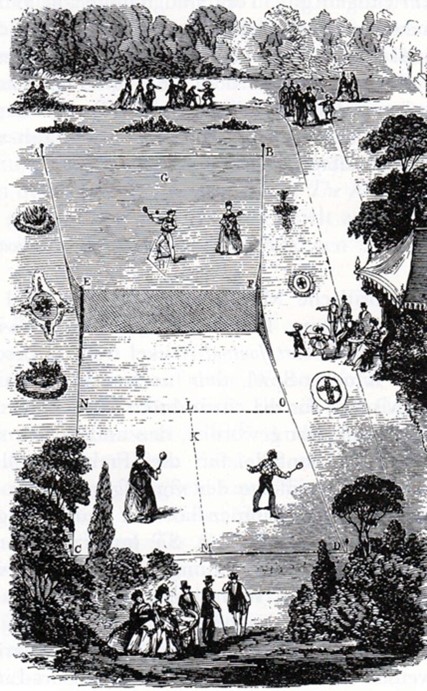By Harry Benscher
Over the past few decades, the game of tennis has evolved to new heights, a true ace of the sporting world. In this article, I will go through the evolution of tennis and how it has changed this world.
Where did it come from?
Tennis came from a game called jeu de paume, which directly translates to “game of the palm.” It was originally French, and it was where monks hit the ball with their hands. Jeu de paume then transformed to using gloves, then paddles, and finally racquets—all in the 16th century. The version of tennis that we now play evolved from the rules created by Major Walter Clopton Wingfield in 1873.
It was registered as a game in 1873 and called lawn tennis. He also introduced a version called Sphairistike, which is the ruleset that we now play by (with a few changes). Then, in the late 1870s, standardized rules were established, and the first Wimbledon tournament was held (1877).

Tennis Rackets

Tennis rackets have changed a lot throughout the centuries. Originally, they looked a lot like badminton rackets, with the ball also looking very strange. The original rackets were made of wood and animal guts—the wood held the frame, and the animal guts acted like our graphite in the modern age. By the 1980s, the tennis racket strings and frame had changed to almost completely graphite. This advancement meant that players could generate higher speed and spin on the ball.
Now, with so many things to help you get better (like grips), this means that the rankings of the best players in the world change around a lot. Furthermore, the materials used help players hit the ball much harder and faster, leading to a higher level of play. In this age, we still use graphite, kevlar, and carbon fibre for rackets that suit the aggressive playing styles of today.
Some modern innovations that have emerged are:
- Oversized heads introduced (late 1970s)
- Vibration dampening (1990s onward)
- Open string patterns (2000s)
- Custom weight and balancing (2000s)
- Smart rackets with sensors (2015)

Social Impacts
Tennis has promoted many things over the years: physical fitness, mental health, community engagement, and opportunities for all kinds of people. It has meant that more people exercise and become healthier because of tennis. Tennis improves your life and how long you live it. In the British Journal of Sports Medicine, it states that tennis players have a 470% lower risk of death from any cause compared to non-players. It also gives you a stronger community, when you are playing with random people or neighbours around you – it strengthens your support network. Playing tennis helps with your memory, concentration, and reaction time, which trickles down to other endeavours like academics. Furthermore, it burns more calories than many other sports – you burn approximately 400-600 calories per hour by playing tennis. Tennis has had many benefits on the wider community, from bringing everyone together to support the sport to improving everybody’s health.

Rule Changes
Some recent rule changes in tennis have affected the game a lot. For example, the rule allowing coaches to coach while on the field of play has massively affected how the top players play the game. Some other rule changes include the removal of line judges and the match scheduling rule. The removal of line judges means that it is the technology that calls it out automatically if the umpire requires it, rather than an actual person. This means there is a lot more reviewing of calls (technology review) than before. The match scheduling means that a tennis match cannot start after around 11 p.m., and there is a ban on anything more than 5-day matches, so players won’t be playing after midnigt at all. It will also mean that the latest the night session can start is 7:30 p.m. Furthermore, since March 2022, all Grand Slam events have used a 10-point tiebreak in the final set for even more action. This rule change was made so that this final tiebreak focuses on consistency to reduce exhausting long matches.
The Grand Slams

The Australian Open. The Australian Open is a Grand Slam that was first played in 1905. At first, it was just between New Zealand and Australia, but by 1923 it was internationally recognized as one of the Grand Slams. The first woman to win the Australian Open was Margaret Molesworth in 1922. It was originally rotated between Australian cities, but then it changed to a few different locations before finally settling at Melbourne Park. Originally, this was a grass-court tournament until it changed in 1988 to hard courts. The hard-court material varied over the years, going from Rebound Ace (1988–2007) to Plexicushion (2008–2019), and then finally GreenSet (2020 onwards). All these different materials had their own characteristics: lower bounces and firmer courts. The person with the most titles right now is Novak Djokovic, with 10 titles. For women, it is Margaret Court, with 11 titles.

Roland Garros. Roland Garros, also known as the French Open, was first held in 1891. It was originally limited to French club members, but it then became an international event in 1925, allowing everyone to compete. Roland Garros was a French aviator and WW1 hero, and it has been held at Stade Roland Garros since 1928. It was played on clay courts, and it still stands true to this day. A clay court makes the ball the slowest out of all the surfaces; it is iconically known for its clay court, being the only clay court Grand Slam. The man with the most titles there is Rafael Nadal with 14 titles. For women’s, it is Chris Evert with 7 titles during her career.

Wimbledon. Wimbledon is the oldest tennis tournament in the world. It was first held in 1877. It started off as a men’s singles-only event, then gradually evolved to include women’s singles and men’s doubles in 1884. It has always been played on grass courts, maintaining the rules set in lawn tennis by Major Wingfield. Some things that have changed throughout the centuries are:
- Introduction of tiebreaks in early rounds (1967)
- Hawk-Eye technology introduced to challenge line calls (2006)
- Wimbledon became the last Grand Slam to award equal prize money to men and women (2007)
- Installation of a retractable roof (2009)
- Wimbledon announces removal of all line judges (2025)
Wimbledon is still known for its strict code of conduct and strict dress code. From the beginning, they have had behavioural guidelines and fines that are issued to people who violate them. It is also compulsory to wear a full white outfit when playing in this Grand Slam

US Open. The US Open was founded in 1881 (for men’s) and 1887 (for women’s) and is the last Grand Slam that we will be covering in this article. It was originally a grass court Grand Slam, then changed to clay court (1975–1977), and finally to hard court (1978–present). They were the first of the Grand Slams to do two things:
- Prize money equality (1973)
- Night matches introduced (1975)
Along with all the rule changes that the other Grand Slams had (e.g. Hawk-Eye technology and final set tiebreak), the US Open continues to be played at the USTA Billie Jean King National Tennis Center in New York. The man with the most titles at the US Open is Bill Tilden (pre-Open Era), and the woman is Molla Bjurstedt Mallory with 8 titles (pre-Open Era).
